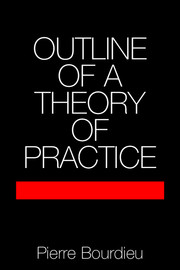3 - GENERATIVE SCHEMES AND PRACTICAL LOGIC: INVENTION WITHIN LIMITS
Published online by Cambridge University Press: 05 March 2013
Summary
The opposite gesture, that of inverting a spoon, should automatically, as it were, provoke a contrary action. This is what the wife of a fqih does, among the Mtougga, to ward off imminent rainfall.
E. Laoust, Mots et choses berbères“I think I've made a new theological discovery…”
“What is it?”
“If you hold your hands upside down, you get the opposite of what you pray for!”
Charles M. Schulz, There's No One Like You, SnoopyMan differs from other animals in that he is the one most given to mimicry (mimetikotaton) and learns his first lessons through mimesis (dia mimeseos).
Aristotle, Poetics, 1448bObjectivism constitutes the social world as a spectacle presented to an observer who takes up a “point of view” on the action, who stands back so as to observe it and, transferring into the object the principles of his relation to the object, conceives of it as a totality intended for cognition alone, in which all interactions are reduced to symbolic exchanges. This point of view is the one afforded by high positions in the social structure, from which the social world appears as a representation (in the sense of idealist philosophy but also as used in painting or the theatre) and practices are no more than “executions”, stage parts, performances of scores, or the implementing of plans.
Information
- Type
- Chapter
- Information
- Outline of a Theory of Practice , pp. 96 - 158Publisher: Cambridge University PressPrint publication year: 1977
Accessibility standard: Unknown
Why this information is here
This section outlines the accessibility features of this content - including support for screen readers, full keyboard navigation and high-contrast display options. This may not be relevant for you.Accessibility Information
- 3
- Cited by
